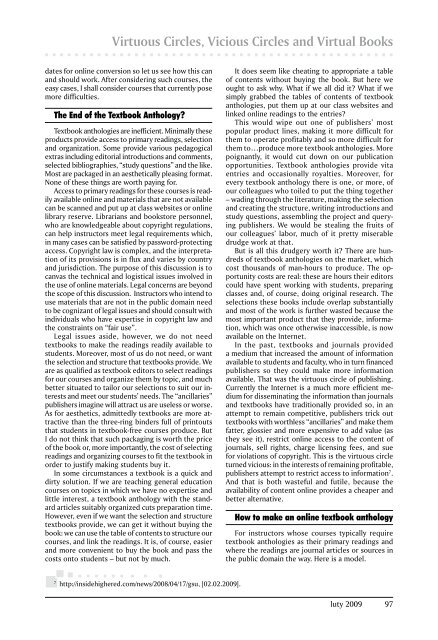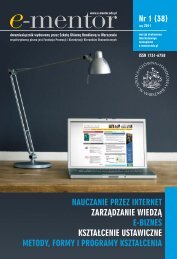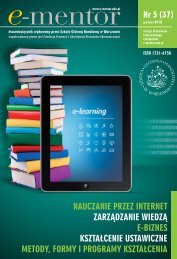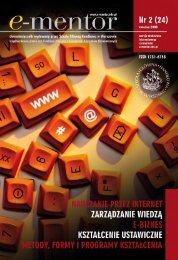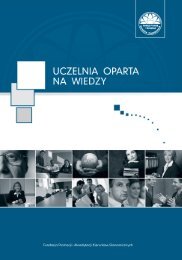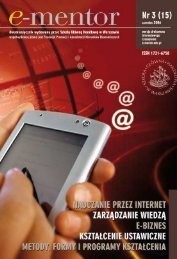e-<strong>edukacja</strong> na świecieing them from the dross. Moreover, in some fieldsat least, the Market has not served to improve thequality of commercial products and there is morejunk in hardcopy than there is online. Arguably, thisis because the reluctance of instructors to use onlinealternatives gives commercial publishers as a groupa monopoly and, in fields where there is a standard,more or less static package of material that studentsneed, they compete with one another in makingcosmetic changes, inflating texts and introducingworthless gimmickry – producing textbooks thatrange from bad to worse.To see how this dynamic works we only have toconsider the large market for introductory logic textbooksaimed at courses commonly known as “babylogic”. I have dozens of free samples and in any givenacademic year numerous publishers’ reps visit me totry to sell their products – and encourage me to writeyet another baby logic textbook for them. Over theyears, these books have become glossier, more gimmickyand more expensive. There just isn’t that muchyou can do with baby logic. It’s like college algebra.There are certain things you have to know, certaintechniques you need to learn, and that’s that. Sopublishers compete by producing books with distinctionsthat make no difference or inflating. I recentlycompleted a survey by a publisher who wanted toknow whether I preferred horseshoes (UK: hooks)or arrows for material implication and plain “x’s” orupside down “A’s” for the universal quantifier. I personallyprefer upside down “A’s”, arrows, double arrows,upside down wedges for conjunction and “hoes” fornegation but I am not going to switch to a textbookfor typographical reasons. This is wasteful baloney.So, in at least some fields, the market is not workingand, arguably, it might work better if online alternativeswere competitive. And online alternatives wouldbe competitive if instructors would seriously considerthem. Rob Breezer, the professor of mathematics citedin the Inside Higher Ed article, remarks: “The worlddoesn’t need another linear algebra textbook on themarket—it needs a free one” 4 .But money isn’t everything and for many coursesthe most important reason for using online resourcesis quality, flexibility for instructors and conveniencefor students. The article describes the experience ofJohn Gallaugher, an associate professor of informationsystems at Boston College’s Carrol School of Management,teaching a graduate-level introductory coursein information systems: The book cost about $150. Healso assigned supplemental reading — trade press articles,online case studies and the like. Student feedback wasclear: The textbook cost was too high, and they valuedthe supplemental material more. He agreed on the pricecomplaint, calling some versions “oppressively expensive”.So Gallaugher stopped assigning the textbook and begandeveloping syllabuses from existing online materials, includinghis own. He’s posted PowerPoint slides and podcasts ofhis lectures online ever since 5 .There are ample resources for business educationonline. University of Pittsburgh professor BerniePoole, for example, links a wide range of resources at“Business Education Resources” 6 and most economicsjournals are available through databases to whichuniversity libraries subscribe.A textbook, however carefully chosen, is never exactlywhat we want in either organization or content.So, like Gallaugher, most of us introduce extensivesupplementary materials and reorganize the textbookon our syllabi. This is inconvenient as well as expensivefor students. Consider the plight of Gallaugher’sstudents before his conversion. After shelling out $150for the textbook, they had to go online to access casestudies and assemble photocopies of trade press articles“and the like” which Gallaugher either distributedin class or placed on library reserve.From the instructor’s point of view it is even worse.Because many of us perceive traditional commercialtextbooks as de rigeur, we teach the text. For lowerdivision undergraduate courses in logic, math and thelike this isn’t particularly bad. Students need to knowabout modus ponens and the quadratic formula. But ifwe’re teaching courses where the “canon” is shifting,where students need to be cogniscent of recent workor where there is disagreement about what studentsshould read it is disastrous to teach the text.Keeping up with research in our fields, we knowwhat students should be reading. But once we sockstudents with the cost of expensive textbooks, manyof which are outdated by the time they appear in print,we feel morally obliged to use enough of the text tojustify the expense – whatever enough turns out tobe. The hardcopy textbook model, and many distancelearning and online teaching approaches, level down:they reduce academics, who are qualified, willing andable to assess and produce teaching materials in theirfields given their knowledge of current research, tomere teachers whose job it is to work through standardtexts and correct exercises – a waste of talent,knowledge and commitment. The availability of onlineresources levels up: it facilitates university professors’task of using their research for pedagogical purposesand makes it possible for educators at every level, whoare willing and able, to produce customized teachingmaterials.To see how this can work let us first considercourses where this kind of customization is unproblematicand how such courses can effectively be putonline. I have suggested that classes in which theprimary readings are journal articles and selectionsof historical sources, typically collected in textbookanthologies are, currently, the most suitable candi-4http://insidehighered.com/news/2008/04/16/textbooks, [02.02.2009].5http://insidehighered.com/news/2008/04/16/textbooks, [02.02.2009].6http://www.pitt.edu/~poole/business.html, [02.02.2009].96 e-<strong>mentor</strong> nr 1 (28)
Virtuous Circles, Vicious Circles and Virtual Booksdates for online conversion so let us see how this canand should work. After considering such courses, theeasy cases, I shall consider courses that currently posemore difficulties.The End of the Textbook Anthology?Textbook anthologies are inefficient. Minimally theseproducts provide access to primary readings, selectionand organization. Some provide various pedagogicalextras including editorial introductions and comments,selected bibliographies, “study questions” and the like.Most are packaged in an aesthetically pleasing format.None of these things are worth paying for.Access to primary readings for these courses is readilyavailable online and materials that are not availablecan be scanned and put up at class websites or onlinelibrary reserve. Librarians and bookstore personnel,who are knowledgeable about copyright regulations,can help instructors meet legal requirements which,in many cases can be satisfied by password-protectingaccess. Copyright law is complex, and the interpretationof its provisions is in flux and varies by countryand jurisdiction. The purpose of this discussion is tocanvas the technical and logistical issues involved inthe use of online materials. Legal concerns are beyondthe scope of this discussion. Instructors who intend touse materials that are not in the public domain needto be cognizant of legal issues and should consult withindividuals who have expertise in copyright law andthe constraints on “fair use”.Legal issues aside, however, we do not needtextbooks to make the readings readily available tostudents. Moreover, most of us do not need, or wantthe selection and structure that textbooks provide. Weare as qualified as textbook editors to select readingsfor our courses and organize them by topic, and muchbetter situated to tailor our selections to suit our interestsand meet our students’ needs. The “ancillaries”publishers imagine will attract us are useless or worse.As for aesthetics, admittedly textbooks are more attractivethan the three-ring binders full of printoutsthat students in textbook-free courses produce. ButI do not think that such packaging is worth the priceof the book or, more importantly, the cost of selectingreadings and organizing courses to fit the textbook inorder to justify making students buy it.In some circumstances a textbook is a quick anddirty solution. If we are teaching general educationcourses on topics in which we have no expertise andlittle interest, a textbook anthology with the standardarticles suitably organized cuts preparation time.However, even if we want the selection and structuretextbooks provide, we can get it without buying thebook: we can use the table of contents to structure ourcourses, and link the readings. It is, of course, easierand more convenient to buy the book and pass thecosts onto students – but not by much.It does seem like cheating to appropriate a tableof contents without buying the book. But here weought to ask why. What if we all did it? What if wesimply grabbed the tables of contents of textbookanthologies, put them up at our class websites andlinked online readings to the entries?This would wipe out one of publishers’ mostpopular product lines, making it more difficult forthem to operate profitably and so more difficult forthem to…produce more textbook anthologies. Morepoignantly, it would cut down on our publicationopportunities. Textbook anthologies provide vitaentries and occasionally royalties. Moreover, forevery textbook anthology there is one, or more, ofour colleagues who toiled to put the thing together– wading through the literature, making the selectionand creating the structure, writing introductions andstudy questions, assembling the project and queryingpublishers. We would be stealing the fruits ofour colleagues’ labor, much of it pretty miserabledrudge work at that.But is all this drudgery worth it? There are hundredsof textbook anthologies on the market, whichcost thousands of man-hours to produce. The opportunitycosts are real: these are hours their editorscould have spent working with students, preparingclasses and, of course, doing original research. Theselections these books include overlap substantiallyand most of the work is further wasted because themost important product that they provide, information,which was once otherwise inaccessible, is nowavailable on the Internet.In the past, textbooks and journals provideda medium that increased the amount of informationavailable to students and faculty, who in turn financedpublishers so they could make more informationavailable. That was the virtuous circle of publishing.Currently the Internet is a much more efficient mediumfor disseminating the information than journalsand textbooks have traditionally provided so, in anattempt to remain competitive, publishers trick outtextbooks with worthless “ancillaries” and make themfatter, glossier and more expensive to add value (asthey see it), restrict online access to the content ofjournals, sell rights, charge licensing fees, and suefor violations of copyright. This is the virtuous circleturned vicious: in the interests of remaining profitable,publishers attempt to restrict access to information 7 .And that is both wasteful and futile, because theavailability of content online provides a cheaper andbetter alternative.How to make an online textbook anthologyFor instructors whose courses typically requiretextbook anthologies as their primary readings andwhere the readings are journal articles or sources inthe public domain the way. Here is a model.7http://insidehighered.com/news/2008/04/17/gsu, [02.02.2009].luty 2009 97
- Page 2 and 3:
3 Od redakcji3 Aktualnościmetody,
- Page 4 and 5:
metody, formy i programy kształcen
- Page 6 and 7:
metody, formy i programy kształcen
- Page 8 and 9:
metody, formy i programy kształcen
- Page 10 and 11:
metody, formy i programy kształcen
- Page 12 and 13:
metody, formy i programy kształcen
- Page 14 and 15:
metody, formy i programy kształcen
- Page 16 and 17:
metody, formy i programy kształcen
- Page 18 and 19:
metody, formy i programy kształcen
- Page 20 and 21:
metody, formy i programy kształcen
- Page 22 and 23:
metody, formy i programy kształcen
- Page 24 and 25:
e-edukacja w krajuuczniowie powinni
- Page 26 and 27:
e-edukacja w krajuBadania brytyjski
- Page 28 and 29:
e-edukacja w krajuIT literacy), obe
- Page 30 and 31:
e-edukacja w krajuspersonalizowaneg
- Page 32 and 33:
e-edukacja w krajuŚrodowisko tworz
- Page 34 and 35:
e-edukacja w krajuz założonymi ce
- Page 36 and 37:
e-edukacja w krajuniezbędne jest u
- Page 38 and 39:
e-edukacja w krajuPrzykładowa stru
- Page 40 and 41:
e-edukacja w krajuNauczanie język
- Page 42 and 43:
e-edukacja w krajusiedziby odwzorow
- Page 44 and 45:
e-edukacja w krajuMożliwości zast
- Page 46 and 47: e-edukacja w krajuczy różnymi rod
- Page 48 and 49: e-edukacja w krajuPrzydatność ser
- Page 50 and 51: e-edukacja w krajumających na celu
- Page 52 and 53: e-edukacja w krajuDla dydaktyki w s
- Page 54 and 55: e-edukacja w krajuw sieci, powstaj
- Page 56 and 57: e-edukacja w krajuE-learning w orga
- Page 58 and 59: e-edukacja w kraju(24,3 proc. odpow
- Page 60 and 61: e-edukacja w krajuWykres 6. Ocena p
- Page 62 and 63: zarządzanie wiedząw przedsiębior
- Page 64 and 65: zarządzanie wiedząTabela 4. Mapow
- Page 66 and 67: zarządzanie wiedzącyjnej w zarzą
- Page 68 and 69: zarządzanie wiedząTabela 1. Przyk
- Page 72 and 73: zarządzanie wiedząAnaliza sieci s
- Page 74 and 75: zarządzanie wiedząorganization) k
- Page 76 and 77: zarządzanie wiedząSNA, wsparta od
- Page 78 and 79: kształcenie ustawicznePróbę odpo
- Page 80 and 81: kształcenie ustawicznesię z inter
- Page 82 and 83: e-biznesSpołeczne uwarunkowaniamar
- Page 84 and 85: e-biznesłem rynkowym w swojej nisz
- Page 86 and 87: e-biznesnowała rynek przewozów a
- Page 88 and 89: e-biznesZarządzanie transformacją
- Page 90 and 91: e-biznesKrok 1: definiowanie strate
- Page 92 and 93: e-biznes• dostarczonych i planowa
- Page 94 and 95: e-bizneszarządzania portfelem proj
- Page 98 and 99: e-edukacja na świecie“Analytic P
- Page 100 and 101: e-edukacja na świecieWithout surve
- Page 102: e-edukacja na świecieGetting There


